I’m staring at an evolutionary tree of New Zealand wrens when ‘damn it Travers’ rings out. The infamous Victorian collector Henry Hamersley Travers had just struck again.
In front of me also are the delicate historical skins of some of these tiny wrens, frozen in time since the day they were collected. While some are still with us like the pīwauwau rock wren (Xenicus gilviventris), others are extinct like mātuhituhi bush wren (X. longipes) that was only driven to extinction by rats a mere ten years before I was born. More so than fossil bones, these precious skins are hauntingly beautiful in their detail. No need to infer what they looked like alive.
It’s skins like these, and other historical museum specimens, that offer scientists and conservationists a unique window into how our unique biodiversity was faring at the time of European arrival. Having survived the impacts of Polynesian colonisation, some by the skin of their beak, our biodiversity was about to face a new swathe of threats from further environmental modification, ruthless predators, and the museum trade. Continue reading “Lost in translation or deliberate falsification?”

